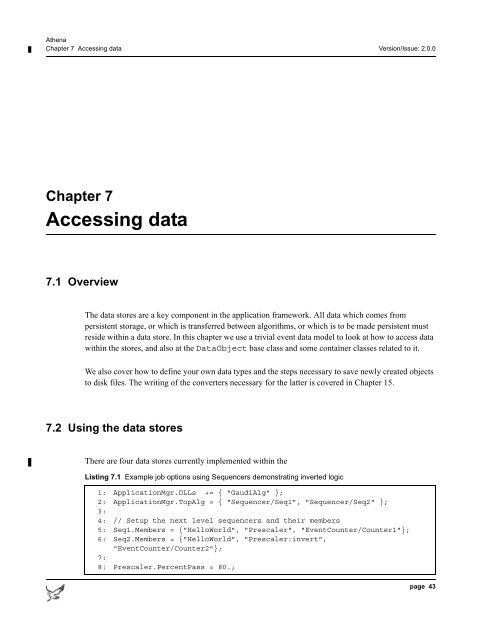Athena Developer Guide
Athena Developer Guide
Athena Developer Guide
You also want an ePaper? Increase the reach of your titles
YUMPU automatically turns print PDFs into web optimized ePapers that Google loves.
<strong>Athena</strong><br />
Chapter 7 Accessing data Version/Issue: 2.0.0<br />
Chapter 7<br />
Accessing data<br />
7.1 Overview<br />
The data stores are a key component in the application framework. All data which comes from<br />
persistent storage, or which is transferred between algorithms, or which is to be made persistent must<br />
reside within a data store. In this chapter we use a trivial event data model to look at how to access data<br />
within the stores, and also at the DataObject base class and some container classes related to it.<br />
We also cover how to define your own data types and the steps necessary to save newly created objects<br />
to disk files. The writing of the converters necessary for the latter is covered in Chapter 15.<br />
7.2 Using the data stores<br />
There are four data stores currently implemented within the<br />
Listing 7.1 Example job options using Sequencers demonstrating inverted logic<br />
1: ApplicationMgr.DLLs += { "GaudiAlg" };<br />
2: ApplicationMgr.TopAlg = { "Sequencer/Seq1", "Sequencer/Seq2" };<br />
3:<br />
4: // Setup the next level sequencers and their members<br />
5: Seq1.Members = {"HelloWorld", "Prescaler", "EventCounter/Counter1"};<br />
6: Seq2.Members = {"HelloWorld", "Prescaler:invert",<br />
"EventCounter/Counter2"};<br />
7:<br />
8: Prescaler.PercentPass = 80.;<br />
page 43
















